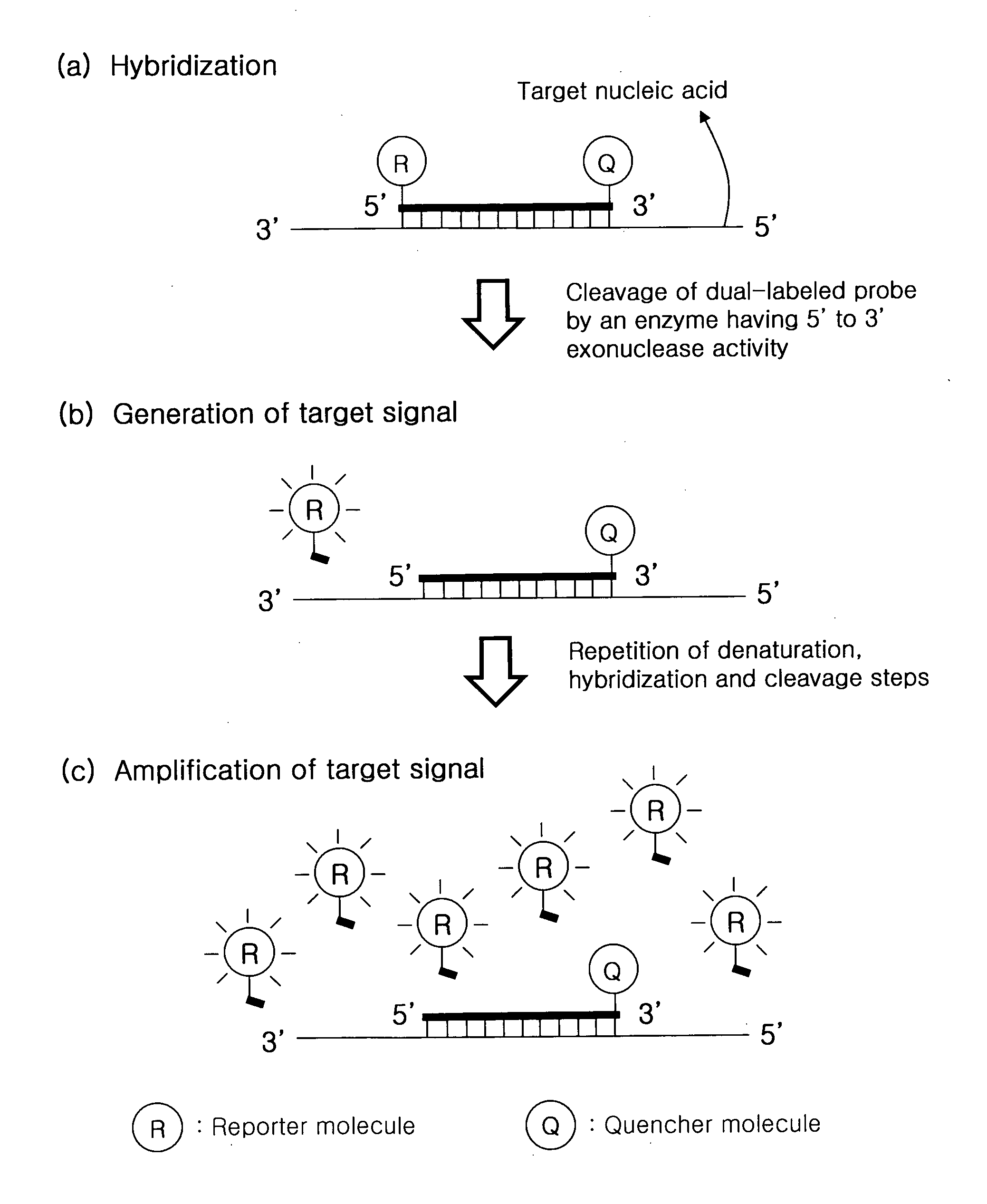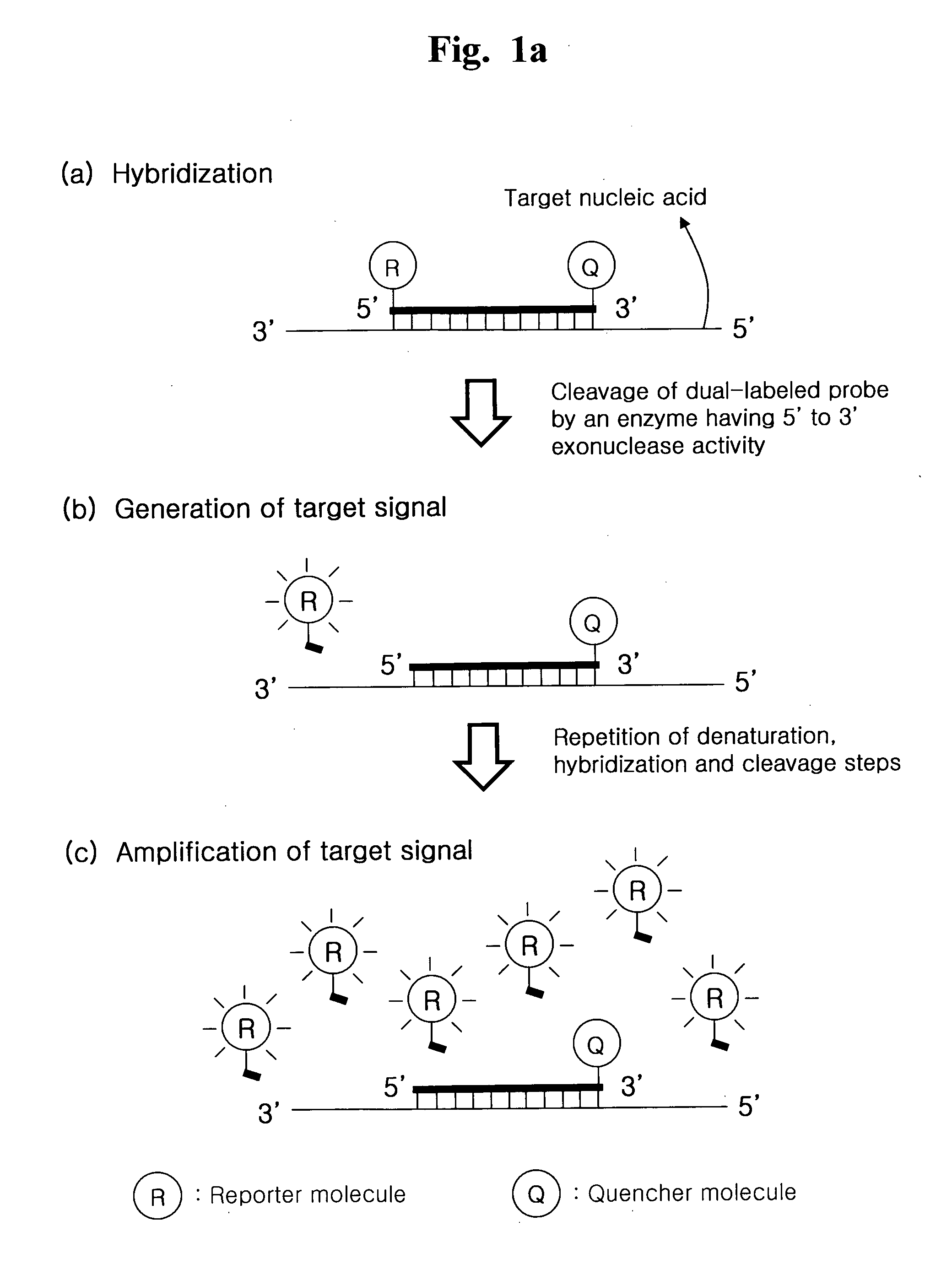Detection of Target Nucleic Acid Sequences by Cyclic Exonucleolytic Reactions
- Summary
- Abstract
- Description
- Claims
- Application Information
AI Technical Summary
Benefits of technology
Problems solved by technology
Method used
Image
Examples
example 1
Evaluation of Cyclic Exonucleolytic Reaction for the Detection of a Target Nucleic Acid Sequence Using DNA Polymerase Having 5′ to 3′ Exonuclease Activity
[0205]Cyclic exonucleolytic reaction of this invention was evaluated whether the cyclic exonucleolytic reaction can generate a signal sufficient to detect a target nucleic, acid sequence using a Taq DNA polymerase having 5′ to 3′ exonuclease activity.
[0206]To examine this evaluation, the synthetic oligonucleotides for Staphylococcus aureus gene and Streptococcus pneumoniae gene were used as templates. A dual-labeled probe has 6-FAM (6-carboxyfluorescein) as a fluorescent reporter molecule at its 5′-end and Black Hole quencher 1 (BHQ-1) as a quencher molecule at its internal sequence. The dual-labeled probe is modified by phosphorylation at its 3′-end, such that the dual-labeled probe is not extended. Cyclic exonucleolytic reactions were conducted using the Taq DNA polymerase having 5′ to 3′ exonuclease activity. The signals were me...
example 2
Evaluation of Cyclic Exonucleolytic Reaction for the Detection of Neisseria gonorrhoeae Gene Using DNA Polymerase Having 3′ to 5′ Exonuclease Activity
[0213]We further examined whether a cyclic exonucleolytic reaction can amplify a signal sufficient to detect a target nucleic acid sequence using a Pfu DNA polymerase having 3′ to 5′ exonuclease activity.
[0214]To examine this evaluation, the synthetic oligonucleotide for N. gonorrhoeae gene was used as a template. A mismatch-carrying dual-labeled probe has a deoxyinosine as a mismatch nucleotide at its 3′-end. The probe is labeled with 6-FAM as a fluorescent reporter molecule at its 5′-end and Black Hole quencher 1 (BHQ-1) as a quencher molecule at its 3′-end. Cyclic exonucleolytic reactions were conducted using the Pfu DNA polymerase having 3′ to 5′ exonuclease activity. The signals were measured at the hybridization step of each cycle.
The sequences of the synthetic template and the mismatch-carrying dual-labeled probe used in this Ex...
example 3
Cyclic Exonucleolytic Reaction for the Detection of S. pneumoniae Gene Using DNA Polymerase Having 5′ to 3′ Exonuclease Activity
[0217]We applied a cyclic exonucleolytic reaction to detect a S. pneumoniae gene using DNA polymerase having 5′ to 3′ exonuclease activity.
[0218]For this application, the amplified products were obtained by using the genomic DNA of S. pneumoniae as a template and a pair of amplification primer (SEQ ID NOs: 7 and 8).
The sequences of the dual-labeled probe and primers used in this Example are:
SP_F(SEQ ID NO: 7)5′-GGTTTCCGTACAGCCTTGA-3′SP_R(SEQ ID NO: 8)5′-TTGACCACTTCGCTATTTCC-3′SP_DLP(SEQ ID NO: 4)5′-[6-FAM]TCCTTCAAACTGTGGATT[T(BHQ-1)]GGGTGT[Phos]-3′
A. Amplification of S. pneumoniae Gene
[0219]The amplification was conducted in the final volume of 20 μl containing 10 ng of S. pneumoniae genomic DNA, 2 μl of 10× DiaStar™ Taq buffer, 2 units of DiaStar™ Taq DNA polymerase (Solgent, Korea), 200 μM each of four dNTPs (dATP, dCTP, dGTP and dTTP), 5 mM of MgCl2, 5 p...
PUM
| Property | Measurement | Unit |
|---|---|---|
| Fluorescence | aaaaa | aaaaa |
Abstract
Description
Claims
Application Information
 Login to View More
Login to View More - R&D
- Intellectual Property
- Life Sciences
- Materials
- Tech Scout
- Unparalleled Data Quality
- Higher Quality Content
- 60% Fewer Hallucinations
Browse by: Latest US Patents, China's latest patents, Technical Efficacy Thesaurus, Application Domain, Technology Topic, Popular Technical Reports.
© 2025 PatSnap. All rights reserved.Legal|Privacy policy|Modern Slavery Act Transparency Statement|Sitemap|About US| Contact US: help@patsnap.com



